Ramailo Mela rumpus
Vault of history: XXXIV Ramailo Mela rumpus
While Nepal keeps running into disputes with its southern neighbor, it rarely does so with the northern one. Only twice have there been serious controversies between Nepal and China—once in 1960 during the parliamentary period (which will be discussed in the next issue) and then in 1967 during the Panchayat era. For a while, it seemed the second one would take on an extreme form, but in the end it was resolved without major ramifications.
In the third week of June 1967, various activities were taking place to celebrate King Mahendra’s birthday. Part of the celebrations was a fair in Brikuti Mandap, Kathmandu, where the Chinese had also set up a stall, at which they had put up a big portrait of Chairman Mao, but not of King Mahendra. On that pretext, a group of ‘nationalist’ students vandalized the Chinese stall. The police were able to disperse the students, but then they started pelting stones at the vehicles belonging to the Chinese parked outside. An abnormal situation arose when people started chanting slogans against the Chinese, in an episode that came to be known as the ‘Ramailo Mela Kaanda’.
China did not take this incident lightly; it issued a strong response, saying that it suspected an Indian or American hand in triggering the vandalism. It sent a letter of protest to Nepal, giving a warning to ‘imperialists, revisionists and reactionaries’. “For encouraging activities like these, they will break their own skulls and their followers will also suffer the consequences of their actions,” it said. China accused the American ‘imperialists’, the Soviet ‘revisionists’ and the Indian ‘reactionaries’ of inciting Nepali hooligans to commit hateful and unseemly acts against the Chinese. (Yadu Nath Khanal, Jeevani ra bichaar, (2059), Sajha Publication).
Those were not the only accusations; China also claimed Nepal had forbidden people from wearing lockets with Mao’s picture and carrying books containing his maxims. Thereafter, Nepal-China relations were strained for a while. China was not only angry about the incident, it also demanded that Nepal accord to the Chinese in Nepal the same status that it accorded to the Indians in the country.
To build understanding with China, Nepal recalled its ambassador to India, Yadu Nath Khanal, and appointed him foreign secretary. Among Khanal’s main briefs was improving relations with the northern neighbor. After a year, a team led by Deputy Prime Minister Kirti Nidhi Bista visited China and held intensive talks with the Chinese, only after which was the matter resolved.
Nepal convinced the Chinese that it had no policy or intent of carrying out anti-China activities. There has indeed been no visible conflict between the two countries following the incident at Brikuti Mandap. China has helped Nepal’s ruling establishment in every political era. The northern neighbor was particularly pleased after the Nepal Army in 1974 quelled the Khampa rebels active in the district of Mustang for the cause of a free Tibet.
Next week’s ‘Vault of history’ column will discuss the ‘Mustang Kaanda’, an incident in which the Chinese army entered Nepali territory and shot dead a Nepali army personnel
The Everest dispute
Vault of history : XXXIII
The Everest dispute
The strategy to minimize the Chinese presence on the East-West Highway continued for a long time. India was displeased that in 1985 a Chinese company won a global bid to build the Kohalpur-Banabasa road section in the far-west under a World Bank loan investment. The southern neighbor put pressure on Nepali rulers to scrap the tender awarded to the Chinese company and ended up investing 500 million Indian Rupees of its own money. Harish Chandra Mahat, then minister for construction and transport, resigned after the annulment of the Chinese contract. But Nepal benefitted, as it did not have to bear the burden of another foreign loan.The ‘Mount Everest dispute’ had been settled with King Mahendra’s visit to China. But the Nepal-China boundary agreement was overshadowed by the controversy that the Kodari Highway generated. As per the boundary accord, which King Mahendra and President Liu Shaoqi had signed on 5 October 1961, Nepal and China agreed to erect border pillars in a manner convenient for both the countries. They agreed to take the historical boundary as a base, but to adjust it on the basis of joint inspections, equality, friendship, mutual interest, and cooperation.
After Mahendra returned from China, a felicitation ceremony was held in his honor in Tundikhel on 27 October 1961. “We are proud to be able to say that Mount Everest, which the whole world seems to be eyeing, falls squarely inside Nepal,” declared Mahendra in a long speech he gave in Tundikhel.
Indian newspapers extensively covered the story on the Nepal-China border accord and weighed in on how easily China had agreed to it. Their view was that China should sign a border agreement with India the same way it had done with Nepal and Burma.
King Mahendra was delighted that he was able to resolve the Everest dispute. Previously, no one in Nepal had paid attention to the northern frontier; everybody took it for granted that the mountains belonged to Nepal. But controversy emerged when China claimed Everest; such a claim was also shrouded in mystery. There was a long discussion in Nepal’s parliament in April 1960 over the Chinese claim and the threat posed by the spread of communism.
Then Prime Minister BP Koirala had said in the parliament that the government would try to bring Chinese Premier Zhou Enlai around on Everest during his impending visit to Nepal. “We have told them that Everest belongs to us. Zhou Enlai is coming to Nepal. I don’t want to say anything other than to request everybody not to spoil the political environment. It won’t be appropriate to get worked up at a moment like this,” Koirala had remarked. Nepal had not expected a border dispute with China before the invasion of Tibet.
Mount Everest had shot to fame following its first ascent by Tenzing Norgay and Edmund Hillary on 29 May 1953. Dispute arose when China placed it within its territory in a map it published in 1954. Some in Nepal were even considering staging a demonstration or waving black flags during Premier Zhou Enlai’s visit. But Prime Minister BP Koirala had said in the parliament that such acts would be unbecoming. And no protest took place when Zhou Enlai came here on 22 April 1960. Instead, the slogan ‘Chini-Nepali bhai bhai, let Nepal-China friendship last forever’ was chanted.
During Zhou Enlai’s visit, Nepal and China agreed “to resolve through normal diplomacy any disagreement or conflict that may arise between the two countries.” They also agreed to form a technical committee to settle the boundary disputes. The agreement helped clear up the differences between Nepal and China.
Next week’s ‘Vault of history’ column will discuss the ‘Ramailo Mela Kaanda’, an incident involving the vandalism of a Chinese stall at a fair in Bhrikuti Mandap
Cold War in Nepal
Vault of history : XXXII
Cold War in Nepal
India did not want Nepal to cultivate deep ties with China. Ever since Nepal established formal diplomatic relations with China on 1 August 1955, India began viewing Nepal suspiciously. Successive Nepali kings and prime ministers started visiting China. India was unhappy about Chinese premier Zhou Enlai’s visit to Nepal on 22 April 1960. India also never approved of Nepali leaders like Tanka Prasad Acharya and Kirti Nidhi Bista who advocated better ties with China.
Work on the highway started with the formation of the ‘Kathmandu-Kodari Highway Construction Committee’ on 25 February 1963. (Later, its name was changed to Arniko highway.) The construction of the 114-km road, which ran from Kathmandu to Kodari on the Chinese border, was completed within two years. Nepalis living in the vicinity of the highway recall interesting stories about the Chinese workers brought in to build the road. According to them, the Chinese used to satirize Nepalis’ indolence.
The Chinese devoted themselves to work day and night and did not like the sights of Nepalis indulging in idle talk, drinking and smoking. The Chinese used to smile when they saw monkeys around the construction site during the day. At night, they hunted them. Although they never did so in front of the Nepalis, the monkey population around the site was wiped out.
King Mahendra had also launched ‘the great campaign’ to build an east-west highway. After the construction of the Kathmandu-Kodari highway, his attention was directed to roads in Tarai. China had showed interest in building a road to the east of Dhalkebar and had even begun preliminary survey work. But India, which was spooked by its recent war with China, did not want China’s presence on its border.
So India decided to build road sections east of Dhalkebar and west of Butwal. The Soviet Union helped with the Pathlaiya-Dhalkebar section; India did not mind that as it had warm relations with the Soviet Union. China had already signed an agreement to build the Dhalkebar-Morang section. Nepal found itself in a difficult spot when India started issuing veiled threats. Scrapping the agreement could draw the ire of the Chinese. According to then Finance Secretary Bhekh Bahadur Thapa, China easily understood Nepal’s predicament. It accepted Nepal’s proposal to let India build that section and divert Chinese investment to another project. Nepal felt relieved by the flexibility of the Chinese, who without fuss directed their investment to the Naubise-Pokhara road section.
Because of its suspicion of the Chinese, India built most sections of the Mahendra highway—which meant lots of Indian contractors, construction workers, and even kitchen staff entered Nepal. Many of them enjoyed their stay in Nepal and settled here. This was in sharp contrast to the limited number of Chinese contractors and workers who came to Nepal and went back to their country after their projects ended. The Chinese had worked on the Sunkoshi project after the construction of the Kodari highway.
When communist nations like China and the Soviet Union started investing in physical infrastructures like roads, factories and power plants, the westerners grew anxious. They also adopted a policy of investing in infrastructure in Nepal. Countries of both blocs—communist and capitalist—competed to give aid to Nepal. Recalls Bhekh Bahadur Thapa, “King Mahendra created an environment for competition between free-market countries and socialist ones. He did so on purpose.”
The next ‘Vault of history’ column will discuss the boundary agreement between Nepal and China, including the resolution of the dispute over Mount Everest
Highway and geopolitics
Vault of history XXXI
Highway and geopolitics
In the speech he delivered in Pokhara in the presence of Indians, King Mahendra said that people were commenting on the proposed link with China without appreciating the fact that he was trying to convert an old commercial mule trail into a modern highway. Mahendra had delivered a long speech, with references to politics, political ideologies, and development. “If they talk about the growth of communism, all I have to say is that ideologies neither grow on trees nor sprout from the ground. They are embraced or rejected based on the times and the circumstances, and on their suitability for a country’s traditions and situation,” he had said. He wanted the Indians to hear this. He needed to allay their and the westerners’ apprehensions about China.
As the talk about the Kathmandu-Kodari highway gained traction, Nepali ministers and ambassadors came out in its defense. Minister Tulsi Giri voiced his opinion rather strongly. “If India does not approve of a road link to the north and if China does not approve of a road link to the south, should Nepal stop building roads?” he asked.
Sino-Indian ties were worsening in those days. In fact, the two countries went to war a year later. China was also openly hostile to the US. Chairman Mao had declared, “Our enemy is the expansionist policy of the US, and its political structures and institutions.” The strained relations between these countries had a bearing on the Kathmandu-Kodari highway. There were even attempts to drag it into controversy and scrap the agreement.
The influence of the Soviet Union, another communist country, on Nepal was also growing. That’s why the western countries, which took the spread of communism seriously, were warning Nepal against its dangers.
King Mahendra had come to a conclusion that the publicity against Nepal could create problems. He even sent a team representing Nepal to the US and the UK to explain the reality surrounding the Kathmandu-Kodari highway. A team of Americans had also come to Nepal to understand the matter. Mahendra’s message was, “Communism won’t travel in a taxi.” (Some said Mahendra had said that it won’t come in a ‘truck’, but actually Mahendra had used the word ‘taxi’.)
To explain things, Mahendra had sent to the US Bhekh Bahadur Thapa, the then member secretary of the National Planning Commission. Thapa had studied in the US and had returned to Nepal just a year earlier. This is how he recalls those days: “King Mahendra had asked me to explain to the Americans, with facts, the reality about Nepal. He wanted me to tell them that Nepal was virtually India-locked and the agreement on the Kodari highway was signed only with the intension of reducing Nepal’s dependence on India; not to promote or embrace the Chinese Maoist ideology.”
Mahendra also employed the Nepali diplomatic missions abroad to ease western suspicions. Nepal’s ambassador to the UK at the time said, “India is angry about the agreement with China. The Indian perspective that Nepal is tilting toward China is flawed. Nepal will never be a communist state during King Mahendra’s reign. Nor will it be China’s client nation. We cannot even imagine communism in Nepal so long as the reins of power are in the king’s hands.” (Grishma Bahadur Devkota, Nepalko rajnitik darpan, Part 3)
Next week’s ‘Vault of history’ column will discuss how Nepalis living in the vicinity of the Arniko highway remember the Chinese workers employed in its construction



















